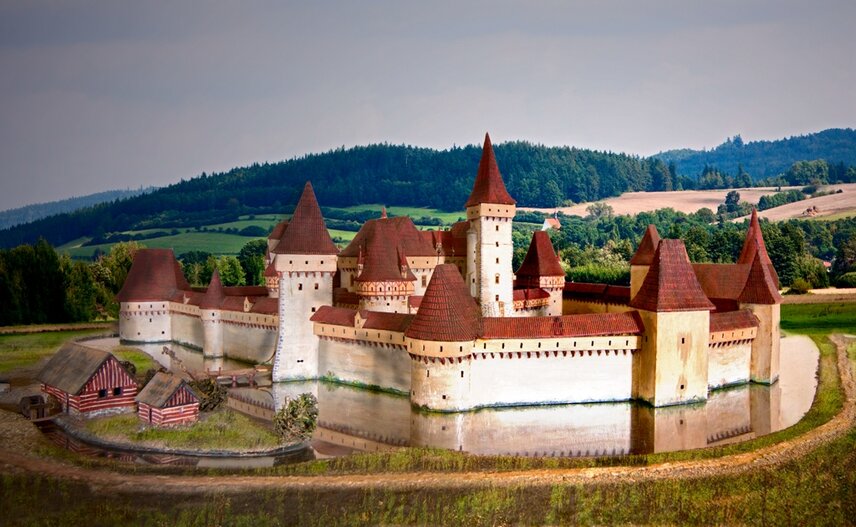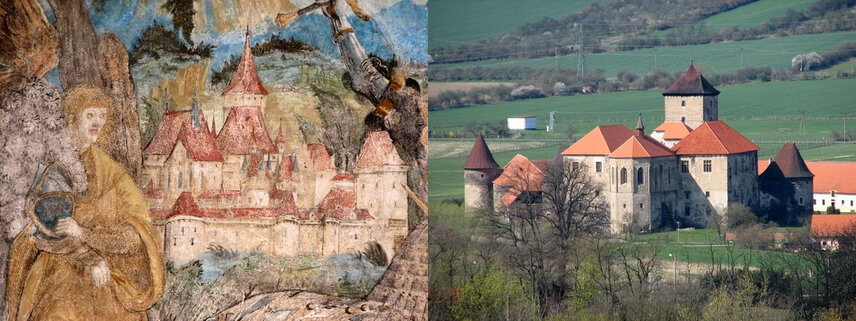History
Brief history of the Švihov castle.


The highest judge, Půta Švihovský, one of the most important men of the Rýzmberk family, had built the Švihov Castle in the late 15th century. He moved up skilfully in the court of King Vladislaus II (from the Jagiełłon dynasty) and acquired considerable influence and assets. In addition to Švihov, Půta also joined the castles of Rabí, Horažďovice and Prácheň to the Rýzmberk estates.
The initial concept for Švihov was an artificial island. The buildings in the central area formed the core of the castle with two palaces, chapel and the staircase tower, thereby enclosing a rectangular inner courtyard. The zones of the internal walls with the four corner bastions and the first moat were protected. The second zone of walls, also with a moat, enclosed the core of the castle and intensified its defence. This second phase of the construction was completed after the death of Půta (in 1504), i.e. at the beginning of the 16th century. The well-known late Gothic architect Benedikt Ried contributed considerably to the completion of construction. Both moats were filled by water from the Úhlava river.
After Půta’s death, the castle was inherited by his two sons, Václav and Jindřich. However, they failed to maintain the estate and gradually had to give up their possessions. They sold Švihov Castle to Heralt Kavka of Říčany and Štěkeň in 1548. His two sons once again sold the castle fifty years later in 1598. This time the buyer was Humprecht Czernín from Chudenice.


The fateful period for the castle occurred in the first half of the 17th century, when it lost its original function. During the Thirty Years' War, it twice resisted the attacks of Swedish soldiers, but after the war, the Emperor Ferdinand III. issued an order for its demolition. Švihov castle lost a large part of the outer fortification and two moats.
Czernin managed to cancel the demolition of the castle. However, the castle continued to be used just as a farmstead. In 1926 it was referred to as a "ruin" in official documents.
The castle survived World War II without major damage and after the war it was confiscated as a part of Czernin’s assets.
In 1947, the just formed National Cultural Commission took over the management of the castle. Almost immediately, it launched a broad-based research and restoration work.
Today the castle is administered by the National Heritage Institute and presented to the general public via three guided tours.


Přehled majitelů hradu
Švihovští z Rýzmberka (13. století–1548)
- Vilém II. z Rýzmberka a ze Skály (přelom 13. a 14. století)
- Břeněk Švihovský z Rýzmberka (druhá polovina 14. století–počátek 15. století)
- Vilém Švihovský z Rýzmberka (počátek 15. století–1472)
- Půta Švihovský (1472–1504)
- Jindřich a Václav Švihovští (1505–1535)
- Jindřich a Jan Půta (Václavův syn) Švihovští (1535–1548)
Kavkové z Říčan (1548–1598)
- Heralt Kavka z Říčan a ze Štěkně (1548–1563)
- Zdeněk a Heralt Kavka mladší Říčanský (1563–1566)
- Heralt Kavka mladší Říčanský (1566–1595)
Černínové (1598–1925)
- Humprecht Černín z Chudenic (1598–1603)
- Jindřich Černín (1603–1640)
- Humprecht Protiva a Jan Maxmilián Černínové (1640–1662)
- Humprech Protiva Černín (1662)
- Jan Heřman Černín (1666)
- František Maxmilián Černín (1666–1699)
- Heřman Jakub Černín z Chudenic (1700–?)
Hospodářská správa (1925–1930)
- Karel Knapp (1925–1926)
- Václav Levora (1926–1930)
Období do současnosti
- Černínové (1930–1945)
- Národní pozemkový fond (1946–1947)
- Národní kulturní komise (1947)
- Národní památkový ústav (současnost)
Přehled stavebního vývoje hradu
- konec 12. století vystavěno zemanské sídlo Držkajů na ostrohu nad řekou Úhlavou
- 1. polovina 14. století Švihovští postavili novou tvrz při řece Úhlavě
- 1425 obléhání tvrze hustiskými vojsky pod vedením Jana Hvězdy z Vícemilic
- 1480 na místě tvrze byla zahájena stavba hradu
- 1505–1530 stavební úpravy hradu, dokončení vnějšího opevnění
- konec 16. století úpravy vnitřního hradu (renesanční malby, fasády,...)
- 1641–1644 obléhání hradu Švédy a vypálení města
- konec Třicetileté války stržení zadní části opevnění, dvou bašt a zahrnutí příkopů
- 18.–19. století přestavba hradu pro hospodářské účely
- 18.–20. století chátrání hradu (v 18. století a roku 1928 hrad označen jako zřícenina)
- 30. léta 20. století nejnutnější opravy hradu
- 1949–1954 rekontrukce
- 1951 archeologický průzkum a v náznacích byl obnoven systém vnějšího opevnění
- do současnosti probíhají práce na obnově a restaurování hradu